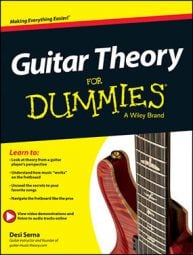The raised 7th in the harmonic minor scale on the guitar is the same pitch as the 3rd of the V7 chord. For example, in A harmonic minor, the Gs is also the 3rd of E7. When you play the Gs over E7, you’re outlining the E7 chord by emphasizing one of its chord tones, the 3rd. You can also outline E7 by emphasizing any of its other chord tones.
Take a look at an E arpeggio pattern in the pentatonic: E, Gs, and B. Here is an E major arpeggio pattern combined with A minor pentatonic. The CAGED form used here for the E chord is the C form. The arpeggio is shown in black, and the rest of the scale is in white. The numbers identify the root, 3rd, and 5th of the E chord.
![[Credit: Illustration courtesy of Desi Serna]](https://www.dummies.com/wp-content/uploads/420305.image0.jpg)
Use any examples or songs that use Am and E7 to practice outlining the complete E major arpeggio over the V7 chord. Try to target one of its chord tones on the first beat of the V7 chord. You can also play several of the chord tones during the measure as time allows.
When the progression returns to the Am chord, stick with A minor pentatonic notes and avoid the raised 7th of the harmonic scale, or the Gs.
The root and 5th of E should still work over the Am chord. After all, the note E belongs to A minor pentatonic, and the B belongs to the A natural minor scale. So in some ways, you’ve just picked up an extra note for your pentatonic patterns — B, in this case — which you can use over both the tonic and dominant chords.
So far, you’ve used a major triad arpeggio to play over a dominant 7th chord, but you can also use a complete dominant 7th arpeggio. Here is an example. You need to add only one note, the note D, to an E chord to make E7. D also belongs to both A minor pentatonic and natural minor scales, so you can use it over both the Am and E7 chords.
![[Credit: Illustration courtesy of Desi Serna]](https://www.dummies.com/wp-content/uploads/420306.image1.jpg)
At this point in your practice, you may have a hard time keeping track of a full dominant 7th arpeggio. If that’s the case, simplify your practice by using just one part of the arpeggio instead of trying to cover all of it. For example, focus on strings 1, 2, and 3. Or skip the dominant 7th for now and just work with the basic triad for a while.
Over time, you can gradually add in more notes and transpose to new keys as you become more proficient.
You can see this in Chapter 14, Video Clip 34: Outlining the V7 Chord in Harmonic Minor.

